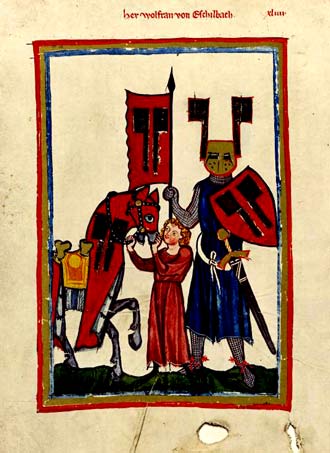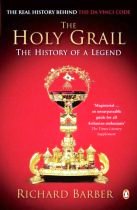Day: August 20, 2007
The cup that runneth over

In his breezily comic novel A Connecticut Yankee at the Court of King Arthur, Mark Twain pokes fun briefly at the cult of the Holy Grail. “The boys all took a flier at the Holy Grail now and then. It was a several-years’ cruise. Every year expeditions went out holy Grailing and next year relief expeditions went to hunt for them. There was worlds of reputation in it, but no money.”
The satire seems gentle enough, but this, at the time when Twain was writing (1889), was already verging on the Victorian equivalent of The Life of Brian. For few subjects had captured the imaginations of poets, artists and composers as strongly as the Grail Quest and its associated Arthurian legends. Wagner was obsessed with it, and Pre-Raphaelite painters lovingly depicted the radiant visions experienced by their androgynous Sir Galahads. Victorian spirituality had seized greedily on a body of myths which, unlike the mythology of Greece and Rome, had an indisputably Christian message at its core: the search for the original cup or dish used by Christ at the Last Supper was a powerful symbol of humankind’s quest for spiritual perfection.
From the hotbed of late 19th-century medievalism, however, some much stranger growths emerged. Members of the “Hermetic Order of the Golden Dawn” (a group which included Yeats) tried to revive the practices of medieval magic and alchemy, and became convinced that if only they could penetrate the secrets of the Grail romances, alchemical treatises, Tarot cards and suchlike, they would become the possessors of a hidden higher truth, a secret doctrine which had been passed down by adepts throughout the ages.
Since then, bizarre theories have proliferated: that the Grail story related to a particular place in Persia, that it was a version of Jewish ritual, or (most famously, given the use made of this theory by T. S. Eliot in The Waste Land) that it was a remnant of an ancient fertility cult. Others have argued, on the slenderest of evidence, that it was bound up with either the Templars or that other standby of medievalist conspiracy theories, the heretical Cathars.
One best-selling modern book even claims, preposterously, that the true secret of the Grail was the “holy blood”, the blood-line of biological descendants of Jesus Christ. Enter any big bookshop, go to the section marked “mysticism” (this sort of thing does sorely test the descriptive powers of bookshop employees), and you will find shelves full of this stuff. Aspiring authors are, in Mark Twain’s words, “taking a flier” at the Holy Grail all the time – and, contrary to Twain’s remark, finding that there is really quite a lot of money in it.
Anyone who has more than a fleeting interest in this subject must often have longed for a rational and reliable account of the whole Grail phenomenon – one that would set out the known facts of when and where these stories appeared, and test the theories against the evidence. This is not an easy task; it requires not just a good grounding in medieval literature and history, but also certain mental or moral virtues – the ability to deal patiently but firmly with the intellectual equivalent of time-wasters. But Richard Barber, who possesses both the medievalist expertise and the requisite calmness and clarity of thought, has managed it at last, and has produced a really valuable and fascinating book.

As Barber clearly demonstrates, the Grail stories were the product not of immemorial legend, folklore or secret cults, but of individual authors: Chrétien de Troyes (who started the whole fashion), Robert de Boron, Wolfram von Eschenbach and some others. They were writing romances, similar to the other (non-Arthurian) romances they also produced, and subject to the same conventions; so, for example, when they claimed that their story was derived from a previous “book” by a mysterious author, this was just a standard fictional device.
In most of these early texts the “secret” of the Grail is, as Barber points out, a secret withheld only from characters in the story (above all, Parsifal, who fails to ask the essential question about it); nothing special is hidden from the reader. These romances do have a theological message, about the veneration of the Eucharist, the body and blood of Christ (the Grail is first described as a dish holding a communion wafer, and is later identified with the cup that held some of Christ’s blood at or after the Crucifixion); but it is a message openly proclaimed in the text. Far from being coded presentations of Cathar heresies or pagan nature-cults, the romances are, as Barber puts it, “quintessentially orthodox in their presentation of the Christian faith”.
One popular theory attributes a purely Celtic origin to the Grail stories, arguing that Chrétien de Troyes’s Perceval (the first text, dating from the 1180s) was inspired by an earlier Welsh poem called Peredur; it is also claimed that the Grail itself originated in the “magic cauldrons” of Celtic mythology. Barber argues convincingly that Peredur is a later imitation, not a predecessor, and politely points out the difference between a communion dish or a chalice and a cooking-pot.
He also describes some of the contemporary factors that must have stimulated interest in the idea of the Grail: the cult of relics (stimulated by the grotesque looting of Byzantine relics during the Fourth Crusade), and the new trends in the liturgy of the Mass. His only notable error comes when he states that in the Catholic Mass both bread and wine are given to the congregation. In fact communion under both kinds was common in the earlier Middle Ages, but the reserving of the wine for the priesthood only was a change that was under way in the period he discusses; this fact would surely have been relevant to his story, as it supplies a further motive for his orthodox romance-writers to promote the veneration – at a distance – of the chalice.
Not only has Richard Barber dealt skilfully with the original medieval evidence; he has also traced the long after-life of the Grail legend, above all in its various 19th- and 20th-century avatars. This not only gives him the chance to investigate some modern literary history (Charles Williams, John Cowper Powys, et al); it also enables him to take a properly historical attitude to the various “loony tunes” modern theories, by setting them in their own historical context.
Overall, then, this is the most reassuringly sane of all modern writings on the whole “Holy Grail” phenomenon. One finishes the book just wishing there were more works like it. Anyone for Nostradamus?

____________________________
Book details
The Holy Grail: The History of a Legend
By Richard Barber
480 pages; £6.49.
Buy it on the Templar Globe Store
